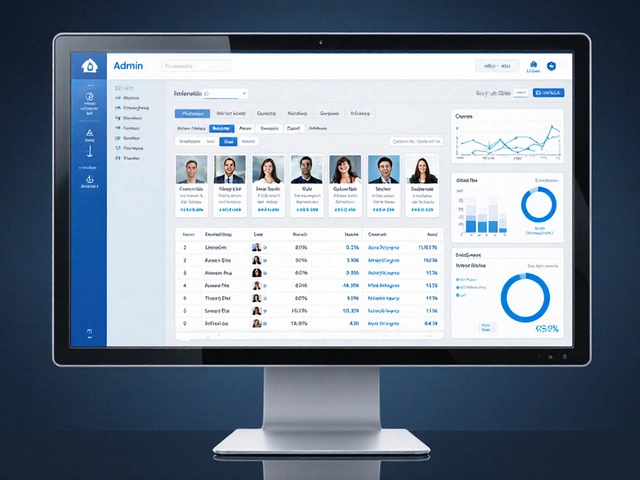Picture this: it's late, coffee's cold, and you're wrestling with a concept you just can't seem to get. Everyone talks about e-learning like it's Hogwarts for adults, promising you can learn anything, anytime. But here comes the real question—are all these e-learning platforms actually any good? Or is it just hype wrapped in slick design and marketing? In 2025, there are dozens of options, each boasting thousands of courses, but only a handful truly deliver the goods. If you've ever wasted hours on a clunky platform or been trapped by sneaky fee structures, you know what I'm talking about. Let’s break down which e-learning platforms are crushing it this year, which ones fall flat, and how you can pick the best home for your next learning adventure.
The Big Names: Comparing Features, Content, and User Experience
When it comes to e-learning platforms, the giants like Coursera, Udemy, edX, LinkedIn Learning, and MasterClass crowd the conversation. Each claims a unique advantage, but what actually sets them apart? Let's pull back the curtain on what these platforms offer beyond the glossy homepage.
Coursera is probably the most recognized name—in 2025, it partners with over 300 universities and major corporations worldwide. Their content is deep: you can go from short skill-based micro-credentials to full online degrees. What makes Coursera stand out is its emphasis on authenticity and academic tie-ins. You can take a course from Yale, Imperial College London, or Google. The assessment process is rigorous, often requiring peer-graded assignments and proctored exams. But there’s a trade-off: the good stuff, like university-backed certifications, often sits behind a paywall. On the plus side, they offer generous financial aid for those who apply.
Udemy takes a different approach—think of it as the wild west of digital courses. Anyone, from seasoned pros to enthusiastic hobbyists, can publish a course. By August 2025, Udemy boasts over 250,000 courses. This massive variety is great if you want quick, practical skills—say, learning to use a niche software or picking up a language for travel. Udemy’s course fees are typically low (they run insane discounts all the time), and you can keep purchased access forever. But the catch? Quality control is hit-or-miss. Some classes are gems; others, not so much. Check the reviews, sample a preview, and take those course ratings seriously.
Then there’s edX, which is famous for being open-source and nonprofit, at least until recently. EdX used to focus on academic, university-led courses, but in 2021, it got scooped up by 2U Inc, a for-profit powerhouse, and the platform has steadily shifted towards more professional education. What stays the same: heavy hitters like MIT and Harvard still put their weight behind courses here. The MicroBachelors and MicroMasters programs attract lots of career-minded learners. EdX’s free audit mode gives access to content for $0, but if you want that verified certificate, cough up the fee.
LinkedIn Learning (formerly Lynda.com) leans into the professional crowd. The main draws here are business, technology, and creative skills, directly tied to LinkedIn's job portal. The platform uses personalized recommendations based on your LinkedIn profile. Every course is bite-sized and highly produced. It’s subscription-only—no lifetime access—but the monthly fee covers thousands of courses. If you’re looking for something practical to boost your CV or ace your next interview, this one's tough to beat.
MasterClass stands on its own, focused less on more and more on star power. Ever wanted to write with Neil Gaiman, cook with Gordon Ramsay, or learn negotiation from Chris Voss? That’s what you get here. The courses are beautifully filmed, and inspirational—but don’t expect assessments, peer interaction, or certificates with real-world weight. Fun fact: by mid-2025, MasterClass had the highest user engagement rate for non-career learners—people stick around for entertainment as much as education.
Here’s a side-by-side snapshot to compare the essentials:
| Platform | # of Courses | Main Focus | Certs/Degrees? | Price Range | Access |
|---|---|---|---|---|---|
| Coursera | 7,000+ | Academic/Professional | Yes | $0-$99+/month | Subscription/one-off |
| Udemy | 250,000+ | All topics | Yes, non-academic | $12-$200/course | Lifetime per course |
| edX | 4,000+ | Academic/Professional | Yes | Free to ~$1000+ | Audit/verified |
| LinkedIn Learning | 21,000+ | Business/Tech/Creative | Certificates | $39.99/month | Subscription |
| MasterClass | 200+ | Creative/Lifestyle | No | $10-$30/month | Subscription |
Need tips for picking between them? Prioritize what you want out of the platform: Is it to add a line to your resume or learn piano for fun? If you want structured progress, graded assignments, and credentials, Coursera or edX has your back. But if you have a fun project or hobby in mind, Udemy or MasterClass usually offers a more relaxed (and often more entertaining) experience. And for brushing up professional skills fast, LinkedIn Learning is a top pick.

Lesser-Known Gems: Specialized Platforms Making Waves
The biggest platforms gobble up the headlines, but some of the best learning happens away from the mainstream. If you dig deeper, you’ll find platforms laser-focused on specific topics or skillsets—sometimes with better student outcomes or unique learning features. Here are a few that stand out this year.
Khan Academy is free, ad-free, and super accessible, especially for middle and high schoolers. It started as a simple YouTube channel but has matured into a huge resource, thanks to support from the Bill & Melinda Gates Foundation and partnerships with major school districts. The interface is simple but powerful—students can track progress, earn badges, and repeat exercises till they nail the concept. Their math modules are used around the world for standardized test prep and even in US prison education programs. Teachers and parents love the data-tracking tools—it’s not fancy, but it just works. If you need step-by-step math help or SAT/GMAT prep without paying a dime, Khan Academy is unbeatable.
Duolingo has turned language learning into a game. By now, you've probably heard someone brag about their streak. In 2025, Duolingo has more than 500 million users and over 40 language options, including Klingon and High Valyrian (seriously). The app uses bite-sized lessons with immediate feedback and growing AI-adaptive difficulty. There’s even a paid Duolingo Max with contextual learning and live tutors. What’s wild is that people who use Duolingo regularly learn at rates similar to university students in beginner courses (a University of South Carolina study backed this up). Is it enough to make you fluent? Probably not alone, but as a starting point or supplement, it’s a no-brainer.
Codecademy and freeCodeCamp shine for programmers. Codecademy is the polished choice, offering interactive, hands-on coding exercises in over 12 languages. Their Pro plan includes real-world projects and career paths mapped out for everything from web developer to data scientist. They’ve partnered with companies like IBM and Facebook on job-ready certificates. freeCodeCamp, on the other hand, remains entirely free and driven by donations. It’s text-based, less flashy, but goes deep: complete challenges, build real projects, and you can earn verified certifications recognized by tech recruiters. Last year, more than 40,000 users reported landing jobs thanks to freeCodeCamp’s curriculum and support forum—proof that price isn’t always the best yardstick for quality.
Want something niche? Skillshare gets creative with topics like photography, animation, podcasting, and illustration, letting anyone publish a course. The subscription model means unlimited access, with a community feel and plenty of peer reviews. Treehouse is laser-focused on tech skills, especially coding bootcamps and UI/UX. FutureLearn is gaining ground in Europe, specializing in humanities and social sciences, thanks to its UK university tie-ins. For those prepping for entrance exams or certifications, platforms like PrepScholar, Magoosh, and Brilliant stand out—with adaptive learning systems and curated study paths. Tip: always look for student success stories that go beyond star ratings; real-world outcomes mean more than a shiny interface.
Here’s a snapshot of these ‘hidden gem’ platforms, plus what they’re best for:
| Platform | Main Focus | Price Range | Standout Feature |
|---|---|---|---|
| Khan Academy | K-12, Test Prep | Free | Adaptive learning & non-profit |
| Duolingo | Language Learning | Free - $12/month | Gameified, AI-based |
| Codecademy | Coding | Free - $40/month | Interactive coding exercises |
| freeCodeCamp | Coding | Free | Real projects, nonprofit |
| Skillshare | Creative Skills | $9.99/month | Community-based peer feedback |
| FutureLearn | Humanities/Social Sciences | Free - £39/month | UK university partnerships |
Looking for that extra edge? Try out trial periods or free versions before you pay—most platforms have them. Test the course navigation, video quality, subtitles, and mobile app performance. The best platform is the one that meshes with your learning style and keeps you coming back. If you lose track of time because you’re so engaged, you’ve found the right fit.

Tips for Picking the Right E-Learning Platform for You
Here’s where things get personal. The "best" e-learning platform isn’t a one-size-fits-all deal. Your choice should depend on your goal, how you learn best, your budget, and even how much social interaction you want. Let’s break down a few key factors to help you zero in on your perfect learning match.
Start by asking yourself why you want to learn online. Is it to land a better job? Master a language? Finally finish that novel or build an app? Your main goal changes which platform fits best. For instance, career advancement usually calls for recognized certificates or degrees—look at Coursera, edX, or LinkedIn Learning. Creative growth and hobbies? Skillshare and MasterClass have you covered. If it’s more academic, like prepping for school or exams, Khan Academy or FutureLearn shine. Coding careers? You’ll likely want Codecademy or freeCodeCamp. And for pure language fun, Duolingo is hard to beat.
Next: budget. Some platforms hide the real price behind free trials or upfront discounts, so pay attention to what you’ll pay long-term. Subscription services like LinkedIn Learning and MasterClass can be affordable if you binge-learn, but get pricey if you stick around for just a few classes. Course-by-course models (like Udemy) mean you pay once and keep access forever. Watch for sales—Udemy often drops course prices from $200 to $15 during promotions. Don’t be shy about applying for financial aid on Coursera or edX, either. Totally broke? FreeCodeCamp, Khan Academy, and Duolingo pack plenty of value for zero cost.
Learning style matters. Are you someone who loves interactive quizzes, or do you prefer watching videos while you cook dinner? User experience can make or break your learning streak. In 2025, platforms are fighting for your attention with addictive progress tracking, AI-powered recommendations, and community features. Test out the dashboard, watch previews, and play with mobile apps before you settle in. Good platforms are intuitive, offer subtitles, and let you learn across devices. Some newer users with ADHD or dyslexia swear by platforms with personalized pacing and built-in accessibility features—always check if that’s a priority for you.
Reviews don’t lie. But go a little deeper than the star rating. Look at student stories or, better yet, search for Reddit threads where folks spill the tea about what working through a course is really like. Does the instructor reply to questions? Are assignments actually reviewed, or do they collect dust? Pro tip: LinkedIn Learning and MasterClass have some of the fastest response times for user support, while Udemy often has the most active discussion boards per course.
And finally—don’t feel bad if you try a platform and it doesn’t click. That’s normal. Switch it up, explore a few, and cherry-pick courses until you find what lights you up. The learning landscape is bigger than ever and keeps expanding—no shame in hopping around. Just remember, the most productive platform is the one you actually use.





Write a comment